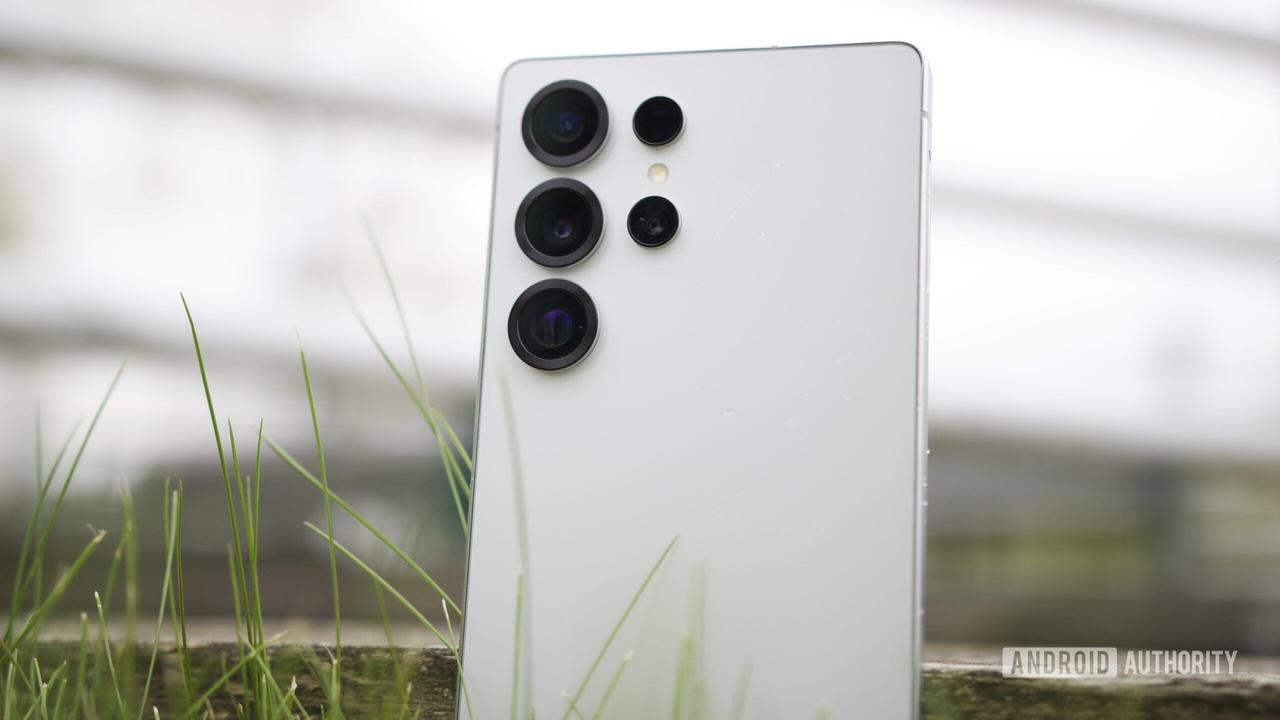Samsung Unveils Exynos 2500: A Game-Changer for the Galaxy Z Flip 7
7 Sources
7 Sources
[1]
Samsung reveals Exynos 2500, the chip behind its leaked Flip 7 shakeup
Leaked reports suggest this SoC will power all Galaxy Z Flip 7 devices worldwide, marking a break from tradition. In the run-up to the eventual launch of the Galaxy Z Flip 7, Samsung has officially unveiled the Exynos 2500 SoC that is largely rumored to power the upcoming flip phone in all markets, including the US. The Exynos 2500 is built on a 3nm GAA process node and features a 1+(2+5)+2 CPU setup comprising one Cortex-X5 (which ARM renamed as the Cortex-X925) clocked at 3.3GHz, two Cortex-A725 at 2.74GHz, five Cortex-A725 at 2.36GHz, and two Cortex-A520 at 1.8GHz. The new SoC uses the Samsung Xclipse 950 GPU, which supports a display of up to 4K resolution and 120Hz refresh rate and hardware-accelerated ray tracing for games. It also supports LPDDR5X RAM and UFS 4.0 storage. The ISP on the Exynos 2500 supports up to 320MP camera sensors and up to 8K 30fps video recording. The Exynos 2500 also comes with the Exynos 5400 modem, which supports 3GPP Rel. 17, enabling mmWave 5G support and peak download speeds of up to 12.1 Gbps. It also supports satellite connectivity, Bluetooth 5.4, and Wi-Fi 7. Samsung is also keen to highlight the NPU on the Exynos 2500, which it claims can run up to 59 trillion operations per second. This allows the Exynos 2500 to claim 39% better on-device AI performance than its predecessor, the Exynos 2400 (though we couldn't locate the TOPS figure for the Exynos 2400). Samsung doesn't mention which device will feature this SoC or when it will launch. However, we've been hearing about the Exynos 2500 coming first to the Galaxy Z Flip 7 for quite some time. Even now, leaker Universe Ice on X reiterated that the Exynos 2500 will be used in all Galaxy Z Flip 7 versions worldwide. If the leak pans out, this would mark the first time the company has deviated from using the same Snapdragon SoC on its flip and fold flagships, as Samsung is expected to use the Snapdragon 8 Elite on the Galaxy Z Fold 7. We'll find out how it unfolds in the coming weeks.
[2]
Samsung unveils its Exynos 2500 chipset, just in time for the Galaxy Z Flip 7's launch
It's far later into 2025 than Samsung likely hoped for, but its Exynos 2500 chipset is finally official, just ahead of next month's rumored Unpacked. The Exynos 2500 is Samsung's first to be built on a 3nm GAA node, a big upgrade over the 4nm process used on the Exynos 2400. As such, it should bring some pretty major efficiency improvements over its direct predecessor. That should be good news for Samsung's foundry business, which has found itself in some pretty poor comparisons with TSMC over the past few years. Samsung says the Exynos 2500 also relies on fan-out wafer-level packaging, or FOWLP, to deliver a slimmer chipset and "enhanced heat dissipation." It's not quite up to par with the Snapdragon 8 Elite's raw horsepower, but the Exynos 2500 still sounds worthy of its flagship status. It's rocking a 1+7+2 CPU core arrangement, complete with Arm's latest Cortex-X925 (née Cortex-X5, which Samsung still uses in its footnotes) rated at 3.3GHz. Its Cortex-A725 performance cores are divided into two groups -- two cores clocked at 2.74GHz, five clocked at 2.36GHz -- while its two efficiency cores are 1.8GHz Cortex-A520s. Samsung says the move to Arm's Cortex-X5 alone should deliver 15 percent improvements over the Exynos 2400 in "big-core performance." Elsewhere, the 4th-gen Xclipse 950 GPU includes support for hardware-accelerated ray tracing, along with repeated support for 4K video output at 120FPS. Its NPU -- always a talking point for chipset companies these days -- is 39 percent faster at processing on-device AI applications, something crucial to practically every Samsung smartphone right now. Its camera capabilities, however, appear unchanged from the Exynos 2400; like last-gen, we're looking at 320MP sensor support and 8K30 video recording. Perhaps most curious -- especially when talking about a new Samsung chip -- is its modem. Samsung's being coy about what modem it's using, delivering a list of specs without specifically referring to anything by name. The company's Exynos 5400 modem, previously found in last year's Pixel 9 series, is a near-match on these listed specs, but with slower FR1 and FR2 maximum download speeds. While flagship Exynos chips typically don't leave much of an impact on North America, that could change in just a short couple of weeks. The Galaxy Z Flip 7 is rumored to be running on the Exynos 2500 globally, and with today's announcement, the stars are finally starting to align.
[3]
Samsung launches Exynos 2500 just ahead of Unpacked -- chip rumored to power Galaxy Z Flip 7
Samsung's latest chip, the Exynos 2500, is apparently ready for primetime after months of rumors that the company was struggling with production yield. Today (June 23), Samsung officially revealed the new system-on-chip, which is widely expected to power the forthcoming Galaxy Z Flip 7. The new processor is being manufactured with Samsung's 3nm Gate All Around (GAA) node, which is expected to improve efficiency. The smaller node should reduce the chip thickness compared to the Exynos 2400, thereby improving heat dissipation. The CPU features a 10-core design with a 1+7+2 arrangement, as described by Samsung. Samsung claims 15% higher performance. It also features a Cortex-X925 core that runs at 3.3GHz, two Cortex-A275 cores at 2.74GHz and five more at 2.36GHz. In general, this appears to be a bit faster than the older Exynos. Beyond that, the new AMD-based GPU should be faster, especially when it comes to ray-tracing-enabled games. Samsung is promoting its AI capabilities, and it does offer up to 59 TOPS, about 39% more than the 2400. It should enable more AI features to work or improve on future Samsung devices. This includes AI-based image processing for sensors up to 320MP, more than enough for the lenses Samsung has been putting in its own phones. You can record at 8K resolution up to 30 fps in video. One big upgrade is to the modem, which is built-in. It now has support for non-terrestrial networks, which means phones using the Exynos 2500 could access satellite messaging. The 5G modem is coupled with Wi-Fi 7 and Bluetooth 5.4 connectivity. Samsung also claims that the analog GNSS interface (GPS-related) has been improved. A couple of days before this announcement, leaker Tarun Vats posted a new Geekbench benchmark that purported to show a device running an Exynos 2500 processor with 12GB of RAM. In that test, the chip scored 2356 points in single-core and 8076 points in multi-core. For comparison, in our testing of the Galaxy S25 base model, which features a Qualcomm Snapdragon 8 Elite chip, it scored 2,916 and 9,886, respectively. The 2500 scores do outperform Google's Tensor G4, used in the Pixel 9 Pro, by quite a bit. Where we might see gains in the Exynos 2500 compared to previous years, especially in the Galaxy Z Flip 7, is in heat dissipation. We saw a number of complaints online that the Snapdragon 8 Gen 3 in the Z Flip 6 overheated quickly on the clamshell phone. Presumably, the heat dissipation of the new Exynos 2500 will be much better, making it last longer without worry of overheating. As mentioned, we believe the Exynos 2500 will feature in the Galaxy Z Flip 7, regular Samsung leaker Ice Cat confirmed as much recently. It could also show up in the rumored cheaper Z Flip 7 FE.
[4]
Samsung unveils Exynos 2500: 4K 120Hz, 320MP sensor, GPU based on AMD RDNA 3
Samsung has officially unveiled the Exynos 2500 chipset specifications, showcasing a new, improved design that ushers in big performance jumps. As an Amazon Associate, we earn from qualifying purchases. TweakTown may also earn commissions from other affiliate partners at no extra cost to you. Samsung has officially unveiled the Exynos 2500 chipset, the company's latest mobile processor that's built on a second-generation 3nm Gate-All-Around (GAA) process. The latest chipset is equipped with a 10-core CPU and a new AMD-based Xclipse GPU and ushers in improvements in AI performance, power efficiency, and camera performance. The details for the new chipset can be found on Samsung's website, and according to the listing, the Exynos 2500 CPU is a tri-cluster architecture and features the following: 1x Cortex-X925 core clocked at 3.3GHz, 2x Cortex-A520 efficiency cores at 1.8GHz, and 2x Cortex-A725 cores at 2.74GHz, and 5x Cortex-A725 cores at 2.36GHz. As for performance gains over the previous generation, Samsung claims a 15% improvement in CPU performance. Moving on to the GPU, the Xclipse 950 GPU has been developed in collaboration with AMD and is based on RDNA 3 architecture. The new GPU ushers in a dual-shader engine that comes with improved ray tracing performance and is capable of increasing frame rates by up to 28% compared to the previous generation. AI performance is expected to get a step up as well, with the Exynos 2500 packing a 24K MAC NPU with a 2-GNPU + 2-SNPU configuration that includes DSP support. Notably, Samsung claims the new NPU is able to hit 590 TOPS, or Trillion Operations Per Second, which is a staggering 39% increase over the previous-gen chip. The Exynos 2500 supports a 320MP single-camera sensor and dual 64MB + 32MP setups, with support for 8K video at 30FPS and 60FPS decode. Additionally, the improved image signal processor comes with multi-layer temporal-spatial noise reduction and dynamic range compression. The Exynos 2500 packs LPDDR5X and UFS 4.0 storage and supports 4K displays up to 120Hz. Lastly, it includes a 5G modem capable of 12.1 Gbps downlink on mmWave, Bluetooth 5.4, and WiFi 7. The Exynos 2500 is expected to debut in the upcoming Galaxy Z Flip 7.
[5]
Galaxy Z Flip 7 set for global 3nm Exynos 2500 rollout
Samsung recently unveiled its new Exynos 2500 system-on-a-chip, which is rumored to power the upcoming Galaxy Z Flip 7 across all global markets, including the United States. The Exynos 2500 is constructed using a 3nm Gate-All-Around (GAA) process node, indicating a focus on advanced semiconductor manufacturing. Its central processing unit (CPU) configuration is detailed as a 1+(2+5)+2 setup. This specific arrangement includes one Cortex-X5 core, which ARM designates as the Cortex-X925, operating at a frequency of 3.3GHz. Complementing this, the CPU integrates two Cortex-A725 cores clocked at 2.74GHz, five additional Cortex-A725 cores at 2.36GHz, and two Cortex-A520 cores running at 1.8GHz. Video: Samsung For graphics processing, the Exynos 2500 incorporates the Samsung Xclipse 950 Graphics Processing Unit (GPU). This GPU is designed to support display resolutions up to 4K with a refresh rate of 120Hz. A notable feature of the Xclipse 950 is its hardware-accelerated ray tracing capabilities, intended to enhance the visual fidelity of gaming applications. The SoC also includes support for LPDDR5X RAM and UFS 4.0 storage technologies, facilitating high-speed data access and overall system responsiveness. The integrated Image Signal Processor (ISP) within the Exynos 2500 is capable of supporting camera sensors with resolutions up to 320 megapixels. Additionally, the ISP facilitates video recording at 8K resolution with a frame rate of 30 frames per second. Connectivity features are handled by the integrated Exynos 5400 modem. This modem adheres to the 3GPP Release 17 standard, enabling mmWave 5G support and achieving peak download speeds of up to 12.1 gigabits per second. Further connectivity options include satellite connectivity, Bluetooth 5.4, and Wi-Fi 7 compatibility. Samsung emphasizes the capabilities of the Neural Processing Unit (NPU) within the Exynos 2500. This NPU is stated to perform up to 59 trillion operations per second (TOPS). This performance contributes to a claimed 39% improvement in on-device artificial intelligence (AI) performance compared to its predecessor, the Exynos 2400. Samsung has not confirmed which specific devices will feature this SoC or its official launch timeline. However, reports from leaker Universe Ice on platform X indicate that the Exynos 2500 will be utilized in all versions of the Galaxy Z Flip 7 globally. This potential deployment strategy would represent a deviation from Samsung's previous approach, where both its flip and fold flagship devices typically utilized the same Snapdragon system-on-a-chip. Current expectations suggest the Galaxy Z Fold 7 will employ the Snapdragon 8 Elite.
[6]
Samsung Exynos 2500 SoC Unveiled Ahead of Next Galaxy Unpacked Event
Samsung says the Exynos 2500 offers 39 percent faster on-device AI performance Samsung's Exynos 2500 chipset has been unveiled as the company's first chipset to be produced using its 3nm process technology. The new processor is claimed to offer up to 15 percent improved CPU performance and 39 percent faster on-device AI performance when compared with the Exynos 2400 chip. It also supports direct connectivity with Low Earth orbit (LEO) satellites for emergency calls and texts. The South Korean technology conglomerate is expected to launch the Exynos 2500 on the upcoming Galaxy Z Flip 7 at a Galaxy Unpacked event next month. While the Samsung Semiconductor website doesn't mention which device will be the first to debut with the company's new Exynos 2500 chipset, it confirms that the product is in mass production. Recent reports indicate that the Samsung Galaxy Z Flip 7, which is expected to arrive next month at a Galaxy Unpacked event, will be the first handset to arrive with the Exynos 2500. The new Exynos 2500 SoC is a 10-core CPU (in a tri-cluster, or 1+7+2 arrangement) that is built using Samsung's 3nm Gate All Around (GAA) process technology and Samsung says the use of fan-out wafer-level packaging (FOWLP) improves heat dissipation and allows the chip to deliver better power efficiency. It comprises one Cortex-X5 core (3.3GHz), two Cortex-A725 cores (2.74GHz), five Cortex-A725 cores (2.36 GHz), and two Cortex-A520 cores (1.8GHz). Samsung says that it can deliver up to 15 percent better CPU performance when compared with the Exynos 2400 chip. It supports LPDDR5x RAM and UFS 4.0 storage. The Xclipse 950 GPU on the Exynos 2500 features AMD's RDNA 3 architecture, and Samsung says that it delivers up to 28 percent faster frame rates for games with hardware accelerated ray tracing. Meanwhile, the NPU on the Exynos 2500 (with 59 TOPS) offers up to 39 percent better performance when using on-device AI features. Smartphones equipped with the Exynos 2500 SoC can support up to a 320-megapixel camera sensor, or two cameras (64-megapixel and 32-megapixel). It also supports up to 8K/ 30fps (10-bit HDR) or 4K/ 120fps video recording. The Exynos 2500 supports up to a 4K display (120Hz) or Quad HD+ display (144Hz). On the connectivity front, the Exynos 2500 offers support for 5G (up to 12.1Gbps), 4G LTE, Wi-Fi 7, Bluetooth 5.4, and NFC. Devices with this chipset can also be equipped with a USB 3.2 Type-C port. The company previously confirmed that the chip will also enable support for satellite connectivity on compatible handsets.
[7]
Samsung's Exynos 2500 Goes Official As The Company's First 3nm GAA Chipset, Features A 10-Core CPU Cluster, New Powerful NPU, Advanced FOWLP Packaging And Much More
The 3nm GAA process is a memory that Samsung wishes it could erase from this timeline, but the company has seemingly defied all odds and managed to materialize the Exynos 2500, with the Korean giant putting up the newest details of its flagship chipset that will reportedly power the upcoming Galaxy Z Flip 7. Like the Exynos 2400, the new SoC will utilize a 10-core CPU cluster while also sporting Samsung's improved FOWLP (fan-out wafer-level packaging), along with other upgrades. Here is more information that you would love to check out. Coming to the CPU configuration, interestingly, Samsung mentions that the Exynos 2500 features a Cortex-X5 core, though it is officially called the Cortex-X925 and runs at 3.30GHz. The remaining cluster includes two Cortex-A725 cores operating at 2.74GHz, five Cortex-A725 running at 2.36GHz, and two Cortex-A520 functioning at 1.80GHz. Unfortunately, if you believe these specifications will challenge the Dimensity 9400, Snapdragon 8 Elite, or Apple's A18 and A18 Pro, we must be the bearer of terrible news. In a previous Geekbench 6 leak, the Exynos 2500 disappoints in both the single-core and multi-core scores, but we are willing to give the chipset the benefit of the doubt and wait for the Galaxy Z Flip 7 to be taken through the same benchmark. Alongside the 10-core cluster, the Exynos 2500 is paired with an Xclipse 950 GPU, support for LPDDR5X RAM, UFS 4.0 storage, and an AI engine whose NPU can deliver up to 59 trillion TOPS, making it 39 percent faster than the Exynos 2400's. Overall, Samsung claims that the chipset's big-core performance improves by 15 percent, with ray tracing support possible thanks to AMD's RDNA3 architecture, delivering console-like graphics from a mobile device. Additionally, the Exynos 2500 adopts the newer fan-out wafer-level packaging, bringing better efficiency and increased heat dissipation. The Galaxy Z Flip 7 is not confirmed to feature a vapor chamber, but assuming that it does, Samsung's latest 3nm GAA SoC can benefit from the added cooling solution. "Increase your productivity while using less power. The Exynos 2500 brings you enhanced power efficiency enabled by improvements in the power reduction architecture across various blocks, as well as the latest manufacturing processes and packaging technology. Built with the cutting-edge 3nm Gate All Around (GAA) process technology, the Exynos 2500 provides better power efficiency and enhanced heat dissipation at a much reduced chip thickness through fan-out wafer-level packaging (FOWLP). Plus, further optimization has been achieved through the aforementioned modifications to CPU core structure and implementation of an analog GNSS interface." Other specifications include a 320MP primary camera and 8K 30FPS video recording. As for wireless connectivity, the Exynos 2500 supports Bluetooth 5.4, Wi-Fi 7, and a 5G modem with downlink speeds of 9.6Gbps for FR1 and 12.1Gbps for FR2. Samsung is scheduled to announce the Galaxy Z Flip 7 at its Galaxy Unpacked event happening next month, and during that time, we shall learn more about the Exynos 2500, so stay tuned for further updates.
Share
Share
Copy Link
Samsung introduces the Exynos 2500, a powerful new chipset built on 3nm technology, rumored to power the upcoming Galaxy Z Flip 7 globally, marking a significant shift in Samsung's chip strategy.
Samsung's Exynos 2500: A Technological Leap
Samsung has officially unveiled its latest system-on-chip (SoC), the Exynos 2500, marking a significant advancement in mobile processor technology. Built on a 3nm Gate-All-Around (GAA) process node, this new chipset is poised to power the upcoming Galaxy Z Flip 7, potentially across all global markets including the United States
1
2
.
Source: 9to5Google
Advanced Architecture and Performance
The Exynos 2500 boasts a sophisticated 10-core CPU configuration, arranged in a 1+(2+5)+2 setup. At its heart lies a Cortex-X925 (formerly known as Cortex-X5) core clocked at 3.3GHz, complemented by two Cortex-A725 cores at 2.74GHz, five Cortex-A725 cores at 2.36GHz, and two Cortex-A520 efficiency cores at 1.8GHz
1
4
. Samsung claims a 15% improvement in CPU performance compared to its predecessor2
.The chipset features the Samsung Xclipse 950 GPU, which supports displays up to 4K resolution at 120Hz refresh rate and introduces hardware-accelerated ray tracing for enhanced gaming experiences
1
4
. The GPU is based on AMD's RDNA 3 architecture and is said to increase frame rates by up to 28% over the previous generation4
.AI and Imaging Capabilities

Source: Tom's Guide
A standout feature of the Exynos 2500 is its Neural Processing Unit (NPU), capable of performing up to 59 trillion operations per second (TOPS). This translates to a 39% improvement in on-device AI performance compared to the Exynos 2400
1
5
. The chipset's Image Signal Processor (ISP) supports camera sensors up to 320MP and enables 8K video recording at 30fps1
3
.Connectivity and Memory Support
The Exynos 2500 integrates the Exynos 5400 modem, supporting 3GPP Rel. 17 and enabling mmWave 5G with peak download speeds of up to 12.1 Gbps. It also includes support for satellite connectivity, Bluetooth 5.4, and Wi-Fi 7
1
5
. The SoC is compatible with LPDDR5X RAM and UFS 4.0 storage, ensuring high-speed data access and system responsiveness1
4
.Related Stories
Implications for Samsung's Strategy
The introduction of the Exynos 2500 potentially signals a significant shift in Samsung's chip strategy. Rumors suggest that this SoC will power all versions of the Galaxy Z Flip 7 worldwide, including in markets traditionally dominated by Qualcomm's Snapdragon chips
2
5
. This move could mark the first time Samsung has deviated from using the same Snapdragon SoC across its flip and fold flagships1
.Performance Comparisons and Future Outlook

Source: Wccftech
While the Exynos 2500 shows promising improvements, early benchmarks suggest it may not fully match the performance of Qualcomm's Snapdragon 8 Elite. A leaked Geekbench test showed scores of 2356 in single-core and 8076 in multi-core performance for the Exynos 2500, compared to 2,916 and 9,886 respectively for the Snapdragon 8 Elite in the Galaxy S25
3
.However, the Exynos 2500's improved heat dissipation capabilities could address previous concerns about overheating in Samsung's foldable devices
3
. As the anticipated launch of the Galaxy Z Flip 7 approaches, the tech community eagerly awaits real-world performance metrics of this new chipset.References
Summarized by
Navi
[1]
[2]
[3]
[5]
Related Stories
Samsung unveils Exynos 2600, world's first 2nm smartphone chip set to power Galaxy S26 series
19 Dec 2025•Technology

Samsung's Exynos 2600 Chip Promises Revolutionary Camera Upgrades for Galaxy S26 Series
06 Nov 2025•Technology

Samsung's Exynos 2600: A Potential Game-Changer for the Galaxy S26 Ultra
20 Oct 2025•Technology

Recent Highlights
1
Google launches Gemini 3 Flash as default AI model, delivering speed with Pro-grade reasoning
Technology

2
OpenAI launches GPT Image 1.5 as AI image generator war with Google intensifies
Technology

3
OpenAI launches ChatGPT app store, opening doors for third-party developers to build AI-powered apps
Technology





